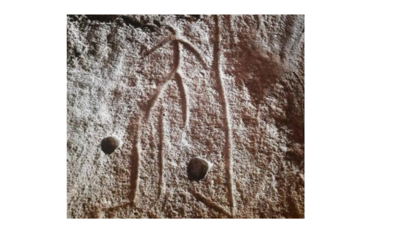Top Searches
- News
- City News
- chennai News
- Rare rock arts found in cave in TN’s Tiruvannamalai district
Rare rock arts found in cave in TN’s Tiruvannamalai district

CHENNAI: Archaeological enthusiasts have discovered petroglyphs, or rock arts, in a cave near Thondamanur village in Tiruvannamalai district of Tamil Nadu.
Members of the Tiruvannamalai District Centre for Historical Research discovered the petroglyphs spread over an area of 10 x 10 feet in the cave.
Secretary of the centre S Balamurugan said that drawings on the wall of the cave had been drawn using a hard object.
A petroglyph is an art form created by carving the rock surface, usually using a stone chisel and hammerstone.
He said they had identified an animal form, which looked like a deer or cow, and a human figurine in this rock art.
The human figurine is seen with its hands extended and in walking position. There is an arrow-like drawing near the left hand of the figurine, with a spearhead and elongated handle.
Two deep holes, more or less in the same size, are seen near the feet of the human figurine. They are called cup marks, which are pre-historic art forms, which consist of concave depressions not more than a few centimetres in width.
There is another form which looks like a human figure drawn using triangles and many lines of various sizes crisscrossing the area.
Art historian K T Gandhirajan, who validated this finding, said that these rock arts are significant as petroglyphs are rare in southern India, when compared to rock paintings or pictographs.
In some regions in India, like Odisha, there were an equal number of petroglyphs and rock paintings. The biggest petroglyph in south India is seen in Edakkal near Vayanadu in Kerala. They are found in Perumukkal near Tindivanam and Errpettu near the Nilgiris.
The details of the rock art in Tiruvannamalai district could be ascertained by studying the orientation of the art form, he said.
Members of the Tiruvannamalai District Centre for Historical Research discovered the petroglyphs spread over an area of 10 x 10 feet in the cave.
Secretary of the centre S Balamurugan said that drawings on the wall of the cave had been drawn using a hard object.
A petroglyph is an art form created by carving the rock surface, usually using a stone chisel and hammerstone.
He said they had identified an animal form, which looked like a deer or cow, and a human figurine in this rock art.
The human figurine is seen with its hands extended and in walking position. There is an arrow-like drawing near the left hand of the figurine, with a spearhead and elongated handle.
Two deep holes, more or less in the same size, are seen near the feet of the human figurine. They are called cup marks, which are pre-historic art forms, which consist of concave depressions not more than a few centimetres in width.
There is another form which looks like a human figure drawn using triangles and many lines of various sizes crisscrossing the area.
Art historian K T Gandhirajan, who validated this finding, said that these rock arts are significant as petroglyphs are rare in southern India, when compared to rock paintings or pictographs.
In some regions in India, like Odisha, there were an equal number of petroglyphs and rock paintings. The biggest petroglyph in south India is seen in Edakkal near Vayanadu in Kerala. They are found in Perumukkal near Tindivanam and Errpettu near the Nilgiris.
The details of the rock art in Tiruvannamalai district could be ascertained by studying the orientation of the art form, he said.
FOLLOW US ON SOCIAL MEDIA
FacebookTwitterInstagramKOO APPYOUTUBE
Looking for Something?

Start a Conversation
end of article










